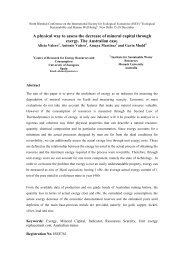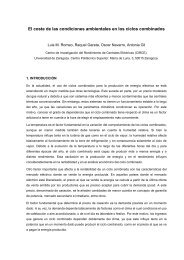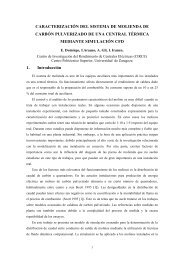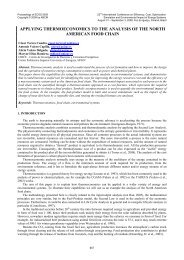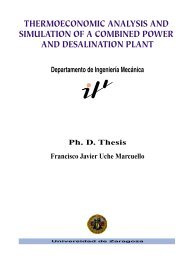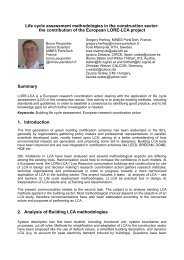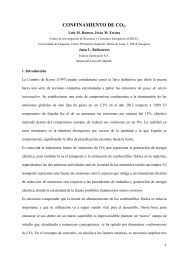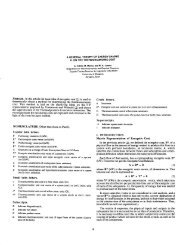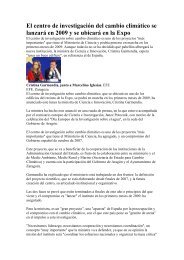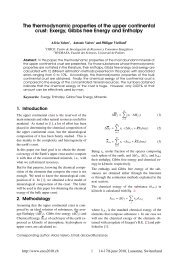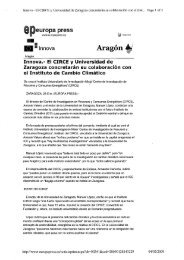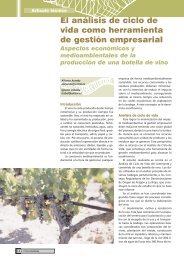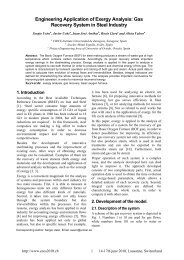CHARACTERIZATION OF A BIOMASS MILLING PILOT ... - circe
CHARACTERIZATION OF A BIOMASS MILLING PILOT ... - circe
CHARACTERIZATION OF A BIOMASS MILLING PILOT ... - circe
Create successful ePaper yourself
Turn your PDF publications into a flip-book with our unique Google optimized e-Paper software.
Input and output temperature measurement of air and<br />
biomass allow to assess the heat flow spent in<br />
temperature increase.<br />
3.2.2 Input and output air humidity and biomass<br />
moisture content<br />
Moisture content is analyzed by means of initial and<br />
final biomass representative sampling [15]. Input and<br />
output air humidity are also instrumented.<br />
Water evaporation flow per mass unity is calculated<br />
considering the difference between input and output<br />
moisture content of biomass.<br />
On the other side, it is necessary to know the initial<br />
air humidity to assess the heat flow to increase the water<br />
vapour temperature.<br />
3.2.3 Biomass feed rate and air mass flow<br />
An average biomass feed rate is calculated as ratio<br />
between total raw biomass weigtht and the measured<br />
feeding time.<br />
Air volumetric flow is instrumented with an annubar<br />
flowmeter located in a pipe stretch in ausence of<br />
particles.<br />
4 MILLED <strong>BIOMASS</strong> SAMPLING<br />
Milling process characterization includes the analysis<br />
and influence of several variables and operational<br />
parameters in the final properties of milled biomass.<br />
First of all, different sampling methodologies to<br />
obtain a representative sample of the total comminuted<br />
biomass in milling experimental pilot plant are reviewed.<br />
4.1 Coning and quartering procedure.<br />
Once the total volume is milled, a representative<br />
sample can be obtained using the coning and quartering<br />
procedure. It is a progressive process, from the bulk<br />
volume (A) two quarters are taken (C and D) and they are<br />
divided into quarters again. The final sample is taken<br />
from the last one (G). The process is shown in figure 3.<br />
Figure 3: Coning and quartering procedure [16]<br />
It is a static sampling method where powder is<br />
confined or heaped. In this situation, size segregation<br />
occurs. Fine particles tend to remain at the center of the<br />
heap and coarse ones congregate at the periphery and the<br />
particle size analyse of the sample is disturbed.<br />
4.2 Gravity discharge sampling.<br />
Sampling from flowing powder such as discharging<br />
flow by gravity, the entire stream of powder should be<br />
sampled by traversing the stream, and the sampling<br />
should continue for a long series of short time intervals.<br />
The sampling point is located between cyclone outlet<br />
and screen classifier (e.g. Fig. 6, GS.1). Particles from<br />
grinders are conveyed until cyclone where are collected<br />
and precipitated to screen classifier. Two-way distributor<br />
(e.g. Fig. 4) has been introduced between both<br />
equipments to change the direction flow on discharge to<br />
the sampling outlet.<br />
This sampling method is simple, economic and<br />
allows taking a representative sample of collected<br />
biomass in cyclone. However, finer particles not<br />
collected by cyclone are not represented in this sample.<br />
Figure 4: Two-way distributor<br />
4.3 Isokinetic sampling<br />
The principal standard for direct measurement of<br />
local particle mass flux in most gas-solid flows is<br />
provided by the isokinetic sampling system. The<br />
isokinetic sampling principle requires that the sampling<br />
probe which is aligned with the flow (isoaxial) extracts<br />
airborne particulates at the sampling velocity matching<br />
the original undisturbed local flow velocity.<br />
In practice, the isokinetic sampling is closely<br />
approached but almost impossible to be rigorously<br />
realized. Several problems as the determination of flow<br />
velocity in the presence of significant amount of<br />
particles, the elimination of intrusive effect of the<br />
sampling probe, the interactions between particles and<br />
carrying fluid, the loss of particles to the wall deposition<br />
and particle bounce/reentrainment in the sampling tube<br />
are frequently observed. By these reasons, three types of<br />
sampling (e.g. Fig. 5) can be carried out: isokinetic<br />
(sampling velocity=stream velocity) or two kind of<br />
anisokinetic sampling: over-sucking (sampling<br />
velocity>stream velocity), under-sucking (sampling<br />
velocity< stream velocity).<br />
Figure 5: Isokinetic and non-isokinetic sampling [17]



